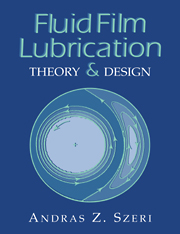Book contents
- Frontmatter
- Contents
- Preface
- 1 Introduction
- 2 Basic Equations
- 3 Thick-Film Lubrication
- 4 Dynamic Properties of Lubricant Films
- 5 Effects of Fluid Inertia
- 6 Flow Stability and Transition
- 7 Turbulence
- 8 Elastohydrodynamic Lubrication
- 9 Thermal Effects
- 10 Lubrication with Non-Newtonian Fluids
- 11 Gas Lubrication
- Index
8 - Elastohydrodynamic Lubrication
Published online by Cambridge University Press: 12 January 2010
- Frontmatter
- Contents
- Preface
- 1 Introduction
- 2 Basic Equations
- 3 Thick-Film Lubrication
- 4 Dynamic Properties of Lubricant Films
- 5 Effects of Fluid Inertia
- 6 Flow Stability and Transition
- 7 Turbulence
- 8 Elastohydrodynamic Lubrication
- 9 Thermal Effects
- 10 Lubrication with Non-Newtonian Fluids
- 11 Gas Lubrication
- Index
Summary
Elastohydrodynamic lubrication (EHL) is the name given to hydrodynamic lubrication when it is applied to solid surfaces of low geometric conformity that are capable of, and are subject to, elastic deformation. In bearings relying on EHL principles, the pressure and film thickness are of order 1 GP and 1 µm, respectively – under such conditions, conventional lubricants exhibit material behavior distinctly different from their bulk properties at normal pressure. In fact, without taking into account the viscosity-pressure characteristics of the liquid lubricant and the elastic deformation of the bounding solids, hydrodynamic theory is incapable of explaining the existence of continuous lubricant films in highly loaded gears and rolling-contact bearings. This is illustrated in the next section, by applying isoviscous lubrication theory to a rigid cylinder rolling on a plane.
When two convex, elastic bodies come into contact under zero load, they touch along a line (e.g., a cylinder and a plane or two parallel cylinders) or in a point (e.g., two spheres or two crossed cylinders). On increasing the normal contact load from zero, the bodies deform in the neighborhood of their initial contact and yield small, though finite, areas of contact; this deformation ensures that the surface stresses remain finite. For a nominal line contact the shape of the finite contact zone is an infinite strip, for a nominal point contact it is an ellipse. Nominal line contacts possess only one spatial dimension and are, therefore, easier to characterize than the two-dimensional nominal point contacts.
- Type
- Chapter
- Information
- Fluid Film LubricationTheory and Design, pp. 267 - 313Publisher: Cambridge University PressPrint publication year: 1998



